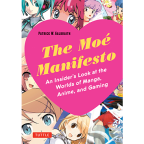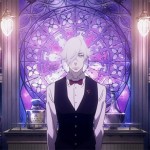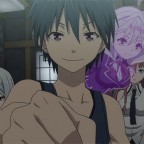Believe It: Anime Sells More Copies In The U.S. Than It Does In Japan
Recently anime fans have become more vocal about the delay between the release dates of DVD/BD anime series in Japan and in the U.S. Except for a couple known examples anime is always distributed first in Japan and only later (sometimes much later) in the U.S. and Europe. The most common reason for these delays are the much higher prices of DVD/BD products in Japan, which allow the production committee and studio behind an anime to at least regain their investment in the series, if not make a profit. Because a series that is sold for 200$ in Japan is usually sold for around 50$ in the U.S. the owners of the show in Japan are reluctant to have it released in the U.S. before the Japanese audience have all but bought their copy of it, for fear of reverse-importing. The common belief (that is not always correct) is that Japanese studios don’t really take the Western audience into consideration while making a show, focusing instead on maximizing the sales of that show in Japan. The Japanese market is the one that fuels the anime economy. That’s a fact. But what will you say if I told you that even though the anime industry is firmly based around the Japanese consumer more people buy copies of anime series in the West than in Japan?
It all goes back to the way in which profit is derived from anime, and the fact that profitability from anime doesn’t always correlate to the amount of people watching it. To explain why this happens let’s widen our view a bit and go beyond the realms of anime. If, for example, you are a game company making the best mobile poker games you will obviously be making most of your profits from the games you created. However, you may want to sell the games at a low price and include in-game updates or upgrades your customer can buy. In this way, you will strive to have as many people as possible buy your poker games, because out of these people some might be willing to pay a premium for the full experience. However, the strategies behind anime are different from the strategies for poker games. Because anime is so expensive to make and copies of it are sold at such an expensive price most of the time the anime is not made in the expectations that it will be profitable on its own. Basically anime is usually made to promote the manga/visual novel/light novel that spawned it. There are some series and movies that are completely original, but even those are usually followed by a plethora of related goods. What is the first thing that springs to your head when someone mentions Neon Genesis Evangelion? If you live in Japan the answer is probably Pachinko, since more people are exposed daily to Pachinko parlors with Neon Genesis Evangelion themed slot machines than are exposed to the actual anime. Not all series manage to become cash-cows, but those that do are milked to the ground. The best example is probably Pokemon, which is a cash-cow in the U.S. almost as much as it is in Japan. If you’re shopping for food in Japan most chances you’ll come across Pokemon curry. If you go with your children to the amusement park you can buy them a Pokemon balloon. In your local ice cream shop they just made a new “Pikachu flavor” and you got a set of those rotating yellow Pokemon toothbrushes as a gift last year. Of course Pokemon is not the only one out there: Dragon Ball, One Piece, Naruto, Precure, Doraemon – any mainstream franchise that made it big is using the anime only as a mean to attract more people to buy related products. If you are a fan who watches all the late night shows you can expect to buy more expensive goods suited for the mediocre to “hardcore” anime collectors such as clothes, drama CDs, wall scrolls, limited edition cookies and basically anything that can be branded.
 “any mainstream franchise that made it big is using the anime only as a mean to attract more people to buy related products.”
“any mainstream franchise that made it big is using the anime only as a mean to attract more people to buy related products.”
In the picture: a Fate/Stay Night T-shirt, a Dragon Ball hat and a Dragon Ball orange soft drink, a pokemon themed
Ramune and a Precure themed curry.
As most of the big money comes from related products the production committee doesn’t really do much to maximize the sales of the anime series itself. You can expect to see commercials for a series main theme song CD, a card game based on the series or even food brands based on it. But I have never heard of a company in Japan that lowered the price of a series so that more people will have access to it. Most of the time they make a limited edition, sell it at 300-400$ and when it’s out of stock it’s gone for good. Some series receive new life when a second season comes around, prompting a small-scoped rerelease of the original series. But these are far and few between. Meanwhile in the U.S. things work differently. Sure, there are a lot of people who buy (and sometimes import) goods related to their beloved series, but there are still considerably more people who consume the anime itself and consider themselves anime collectors. These people collect anime as a medium. Their money is spent mostly on acquiring new series to watch. U.S. distributors are releasing new series and budget bundles of old series left and right. The new series go for about a fourth of their Japanese price, while the budget releases can go as low as 10$ for a complete series. Most of the times U.S. distributors don’t bother, or just can’t, release related goods to series and most of their income come directly from selling series – the opposite of what’s happening in Japan.
Now, in all honesty I don’t really have the figures to prove that anime sells more copies in the U.S. than it does in Japan, but it’s easy enough to grasp it when you take the time to think about it. For example, all my Japanese friends treat Dragon Ball Z as an inseparable part of their childhood and culture. There’s almost an unwritten rule that if you are going to a karaoke hall with friends you’ll be singing Shala Head Shala. But ask any of your Japanese friends if they own a copy of the Dragon Ball Z anime. If your friends are not crazy otaku than most chances are they don’t, because Dragon Ball Z was released on 49 DVDs in Japan and each of these had a retail price of 3,990 Yen. They could have waited and bought the complete series, released as a couple of DVD box sets, but if you bought all of these Japanese DVD boxes you still had to shell out more than 600$. And that’s a series that ended at 291 episodes. More recent series, like Naruto and One Piece, have more than double the amount of episodes and are still on the air. It makes more sense for the Dragon Ball Z fan in Japan to buy the manga, the figures or the video games made for the franchise than to buy the anime DVDs. Japanese who love anime does have a cheaper option though. They can always buy the bundles FUNimation and Viz are offering, which Amazon Japan is all but happy to sell. If you live in Japan and want a copy of Dragon Ball Kai most chances are you’ll reverse-import the U.S. version, because it just makes sense money-wise.
At the end of the day the multimedia economy within Japan is still limiting the ability of fans to acquire anime series legally without reverse-importing. In the meantime prices of anime in the U.S. have plunged and fans can now own most of their series at reasonable prices. What does this ultimately means? In essence it means that while people in the U.S. (and indeed the rest of the West) are not the supporting pillar of the anime industry they are the ones consuming it the most. They buy more physical copies of anime series than the run-of-the-mill Japanese otaku can, because they can afford it. It’s a strange situation in which the Western consumer is not supposed to be targeted by the medium and yet s/he is in a position to own it while the Japanese consumer can at times only own small parts of it. It’s true that when a series hits the air the best place to be to enjoy it and consume its products is Japan. But if you are looking for the most impressive and encompassing anime collection out there most chances are you’ll find it in some American university anime club, not in the land of the rising sun.

















I went to the Tokyo Sky Tree last week and they had a Sazae-san tea shop and a Jump store. On another floor they had a souvenir store filled with cookies and tote bags featuring Pokemon and the K-ON! girls with the Tokyo Sky Tree in the background. They really do try to milk these titles whenever they can.
great post-thank you for explaining how sales in japan vs usa work,i was wondering why they have crazy prices for new release/rerelease anime but now i know
I’m glad you liked it. Thank you for reading.
Nice informative post. Late comment but I missed this article when it
first came out apperantly… but nonetheless I’m not surprised really.
The JP BD prices are aimed at hardcore otaku for sure while the US BD
prices are aimed at general consumers as they want anyone, even people
who aren’t normally fans of anime, to purchase their products because as
you said it’s what they need to sell to get that income they desperatly need. Although I’d exclude Aniplex USA from that list, right? Ha.
Yes, that is correct. Aniplex USA have said on multiple occasions that unlike other publishers they are selling premium products to the hardcore fans who can efford it. They are a good example of a US subsidiary with a Japanese marketing scheme. Aniplex does not differentiate between the Japanese market and the global market and is thus selling at price points that a lot of Western anime fans just can’t accept.
You cite no sources and say you have no figures to support this….so on what are you basing this article? A gut sense? Hunch? Wishful thinking? This is no more than your guesswork masquerading as authoritative fact.
I indeed have no sales figures to support my claim. This article is based on logic and a firm understanding of the market, as well as price comparisons. Trying to insult me in the comments section will not make your accusations any more valid. Furthermore, a few months after this article was written Kadokawa has imposed a soft embargo on Blu-ray releases of their anime series in the U.S. in an attempt to prevent reverse-importation. I think this speaks volumes on how valid my article really is.
“43,000 copies (rounded to the nearest thousand) of the first Fate/Zero box set of were sold in its first week of release, making it the highest-selling television anime Blu-ray box set to date.” http://www.animenewsnetwork.com/news/2012-03-13/fate/zero-tops-haruhi-as-no.1-tv-anime-bd-box-in-1st-week-sales
This same set sold just over 600 in the US.
I strongly suggest you cite a single source for your premise, or pull it as the nonsense it is.
This is funny. You quote the best-selling anime of all time in Japan, and one that sold notoriously bad in the U.S. Of course it sold more copies in Japan. You sir are deceiving people by taking a series that is the exception and presenting it as the norm.
I am not a sir and I am not taking an extreme case, just a random one. The anime that sell better here was stuff Japanese companies dumped on the western audience like Pokemon, which was famously a flop in Japan before it came to America, was resurrected as a success and exported back to Japan.
Great post. I’m in Japan and I agree with you. I shared this post on my facebook. 🙂
Thanks. I’m happy you liked it.
It’s probably relevant to point out that the best-selling title on BD/DVD in the US over the past 8 months or so (AoT part 1) has moved well less than its Japanese equivalent: http://animetics.net/2014/08/10/fun-with-numbers-attack-on-titans-us-release-sold-11748-copies-on-week-1/
These sales figures are interesting, but far from conclusive. Here are some things to consider when viewing them:
1. These are first week sales, not monthly or yearly figure. Anime has a much longer tail in the US than it has in Japan. There is a huge buzz around new releases in Japan that doesn’t exist in the US. Anime fans in the US don’t have any real incentive to buy anime immediately upon its release. Quite the contrary – Anime BD sets stay at a relatively stable (steep) price in Japan while in the US we get huge discounts over time (all major anime retailers do crazy bundles or offer 25% discount or whatnot). So if you try comparing figures based on the first week sales alone you are doing the US sales injustice. I firmly believe the quantity of copies sold in the US for this title will pick up and pass the Japanese release with flying colors in a year or two; Although the Japanese release will probably make the studio more money due to the price difference.
2. Your sales figures are only taken from Amazon (and possibly other small retailers), while Right Stuf is arguably the more prominent western anime store on the net and does not share sales figures.
3.FUNimation has opened their own web store and is selling the limited editions of this title only there (so fans will probably order on that website, which doesn’t post sales figures).
4. There are possibly many people waiting for the second part of this set, or a complete set before they dig into this series.
I would love to get my hands on conclusive sales figures for the US and Japanese anime market for this title (or any other big title for that matter), but those sales figures are impossible to procure due to most web stores not sharing this data. That is why I based this article on educated assumptions. Also, try broadening your time frame a little bit – I’m confident that over the span of two years AOT will sale three times in the US than it sold in Japan. If there is one thing FUNimation know is how to milk their franchises and AOT is not going anywhere any time soon.
1. AoT was discounted 30% even at its release week on amazon, and was 60% off on the second week. Huge discounts set in early enough with big releases that the change in price isn’t necessarily a gigantic factor over time. Even less so when long-term profitability is factored in. Buying a $60 set for $10 in a fire sale doesn’t really help the people who made it that much.
Also, discs do not in fact stay at a static price in Japan either. JP amazon stalker has a page of recent anime releases that are being offered at 50%+ off at any given time, and the list is usually pretty large: http://www27392u.sakura.ne.jp/wagon.cgi
2. The sales figures are from TheNumbers, a sub-project of hollywood data company Opusdata, Inc., not just amazon. I track amazon to see if I can use it as a predictor tool, but those sales figures don’t come from there.
3. This may be a factor in undercounting, but Oricon totals are likewise undercounted b/c of stores not tracked/long tails, typically only getting 40-70% of the distributor total: http://www.someanithing.com/167
Unless you have evidence that specialty retailers regularly do significantly more business than the world’s largest online retail corporation and other general-purpose retailers within the US anime market, you can’t just assume that something is selling enough additional copies in the uncounted grey area to invalidate what hard data there is. Too, there is evidence actually pointing towards amazon (and even b+m stores) as a big player in the more mainstream anime market:
http://www.animenewsnetwork.com/anncast/2014-06-09/.75288
> “The majority of our sales is going to be via Internet, physical
product on the Internet. We still have a heavily physical Blu-ray, DVD
retailer, although the shift has happen towards via sites like Amazon,
RightStuf, everywhere on Funimation.com now. When it comes to physical
retailer, brick-n-mortars, they still play a portion of what we do. We
still have Wal-Marts, who are, you still want to be in on Wal-Mart as
much as possible. If they want you to make a very special thing to
them, we say “yeah!”
-Adam Sheehan, Marketing Manager Funimation. ANNCast 191, 15:00
4. The second set performed basically identically to how the first one did on amazon. If amazon rank is a good predictor of OpusData figures (and it has shown to be so to within a factor of 2 so far) it’s unlikely to radically outperform the sales of set 1.
5. If you add in the long tail of AoT, assuming amazon continues to be indicative of sales at a roughly 100,000/x rate, with (x=daily rank), and assuming it keeps its current daily rank for a year, 100000/672*365~54,000 copies. That’s on the order of the Japanese average, but assumes absolutely no drop-off over time. Also, AoT is a generational hit in America while only being the #5 per-volume show in Japan over the past 5 years (behind Bakemonogatari/Nisemonogatari, Fate/Zero, and Madoka Magica), so using it to show the strength of the US market is probably being generous to said market.
Also, we do have some lower-end sales testimony from Sentai Filmworks representatives suggesting that 3000 lifetime is considered a hit for them:
[After a Sentai Mediaworks panel in Otakon 2012]
> @GNitro: “Sentai admits 3000 sales is considered a hit in the present anime industry. #Otakon2012?
> https://twitter.com/lheiskell/status/229733589305139201
This suggests that a significant number of releases sell below that in their entire lifetime.
You can slice a set of data in different ways, but there are plenty of points of evidence against the idea that the US market outperforms Japan just in terms of units sold. If all you have to base an article on are educated assumptions rather than hard data, it would probably make more sense to write the article as a question rather than an authoritative treatise.
I’m sorry but your opinion is also partly an educated guess. On what basis do you suggest that Amazon sells more anime than Right Stuf? The latter has way more products to sell, displays only anime-related goods, and sell them at a discount of between 25%-90%. Sure, more casual people will probably not know about Right Stuf, but arguably fans who spend money on anime regularly will know about any anime web store out there, and TRS is the biggest anime store out there.
“AoT is a generational hit in America”. Hits don’t always translate to sales. People see things in groups, watch anime for free on Adult Swim, download illegally, or buy things half a year (at best) after they become a hit regardless of the praises they receive. The buzz around AOT in the US at launch was still miniscule compared to the one in Japan. If it is indeed a hit in the US sales of it will possibly grow over time (or remain stable in the US and diminish in Japan), which in the end will strengthen my assumption.
Lastly, since you were nice enough to write these comments and are genuinely trying to prove me wrong I have this to ask of you: why do you (and most of the other people in these comments) assume this post is an academic article? This is a POV – an editorial I wrote that suggests anime sells more copies in the US than it does in Japan. The article was meant to make people ponder the possibility. I would love to hear someday that this editorial proved to be the trigger for a data-oriented academic research on the subject. But my article is just an eye opener – something interesting for anime fans ponder. Nothing more, nothing less.
Amazon also offers figures and other anime-related goods. And has some percentage discount on almost everything too, so the notion that Right Stuff offers qualitatively different shopping because of the discount/offerings isn’t necessarily valid. As was mentioned, AoT part 1 was 60% off in its second week, and it took me all of 2 pages of price-sorted seach results to find a complete collection box there that was 77% off: http://www.amazon.com/Knight-Hunters-Eternity-Complete-Collection/dp/B000BB18K4/
I find it hard to believe that something titled “Anime Sells More Copies In The U.S. Than It Does In Japan” is not making a statement. It’s a poor choice title at best, and the language used within the piece is quite direct; “They buy more physical copies of anime series than the run-of-the-mill Japanese otaku can, because they can afford it.” I do think it’s important to foster debate on stuff like this, but it’s important to parse your language in terms of what you can specualte on and what you can actually prove. As it is, you’ve made strong statements that you can’t back up with solid figures.
Amazing how everyone who has specific, verifiable numbers that you don’t like are just spouting opinion, while your opinion is magically not opinion at all.
Otaku fans in Japan must either be insane or part of the rich elite in Japan. I actually asked a Japanese expat and he assured me that 500€ worth of Yen is considered a lot of money.
Makes sense- the average income of Japan is about the same as my country.
People must be willing to eat noodles for a month to afford a box set of anime. Dedicated indeed 😉
I know this article is 4 years old, but Answerman explain something about anime not being mainstream in Japan:
http://www.animenewsnetwork.com/answerman/2016-06-06/.102903
Sorry for my stupid question, i know that i should probably reread the article again, but i can not ask: why does JP barely translate their games atleast in english and release most of their games on PS PS/Vita?
Your questions is not stupid at all, and not really covered in the article. Localization of games is more related to the size of the company involved. Most AAA (triple A) game companies nowadays do localize their games for the U.S. and Europe. First party games are almost always localized too. So most games that come from Sony, Nintendo and AAA companies such as Square Enix or Capcom find thier way to the West. However, if a game is created by a small company that doesn’t have the resources to localize or export it, then it stays within Japan. For a small company it is easier to only publish for the local market. They lack the infrastracture and partners across the world to publish their games elsewhere. An good example of this would be Type-Moon, which chose not to publish their games outside of Japan despite their great success. It should be noted that growing popularity of digital games and Steam in recent years have made the publication and consumption of Doujin software outside of Japan easier and more streamlined than in past decades.